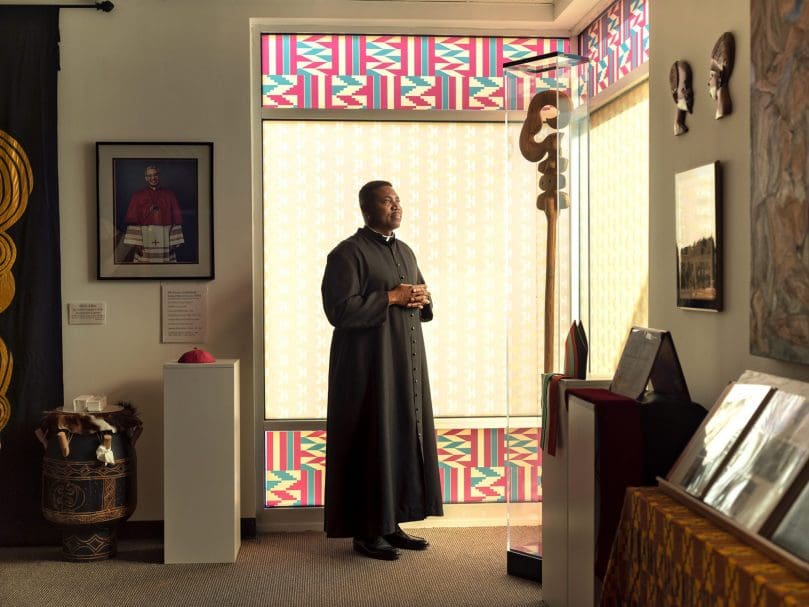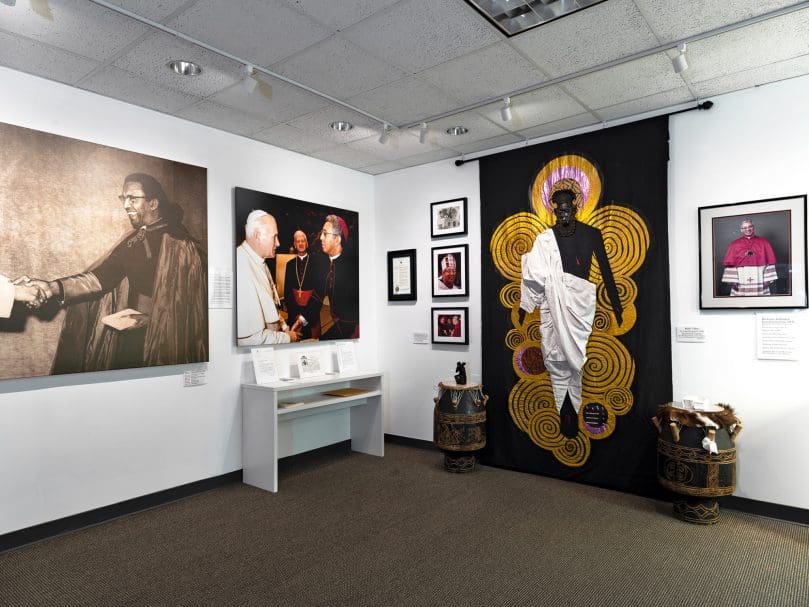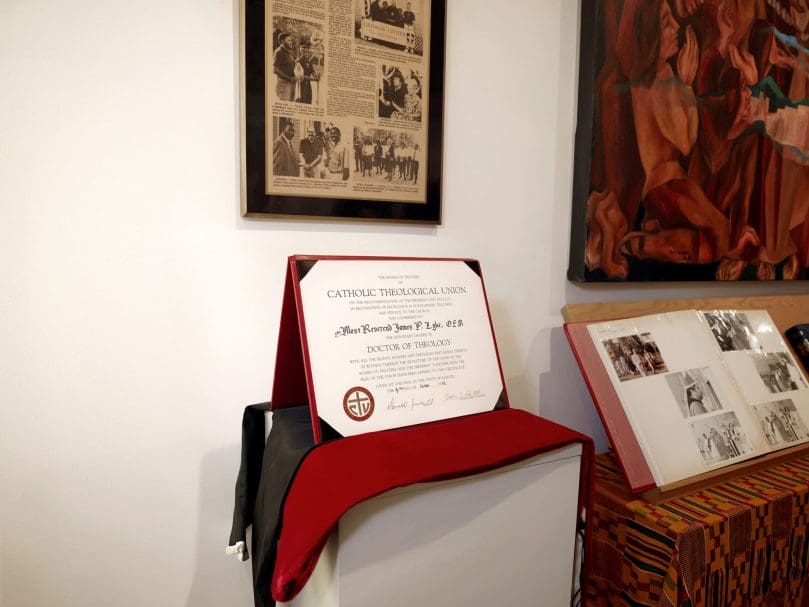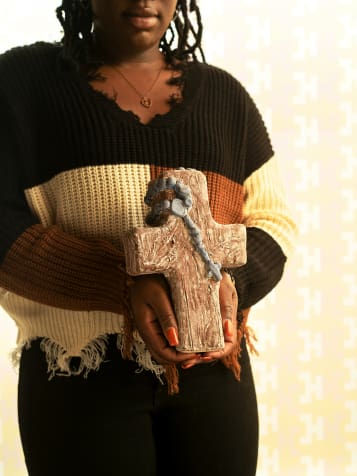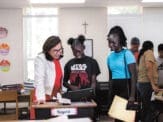Father Urey Mark, chaplain, prays inside the Archbishop James Patterson Lyke Memorial Gallery at Lyke House. Photo by Johnathon Kelso
Atlanta
Lyke House gallery uplifts contributions of Black Catholics
By ANDREW NELSON, Staff Writer | Published November 23, 2021
ATLANTA—In the large artwork, faces of every shape and color stare in adoration at the sun-like Eucharist.
Painted in rich browns and reds, the women and men packed together hold open their hands in solidarity. The broken communion wafer in the mural rises above a golden chalice, with a depiction of shimmering Jesus behind it. Some people hold the Eucharist to consume it. Titled “Communion of Saints,” a man with hands together in prayer, stares at the viewer.
Another piece on the gallery wall is a tapestry of a resurrected Jesus, in a white robe; swirling circles around him like clouds draw him up. His face is a wooden African ritual mask.
This new exhibit at the Lyke House Catholic Center at the Atlanta University Center is honoring its namesake, the late Archbishop James P. Lyke.
The gallery teaches about “these sons and daughters of the Black community who are a gift to U.S. Catholicism and the universal church,” said Father Urey Mark, the director of the center. The Lyke House serves Morehouse College, Spelman College, Clark Atlanta University and Georgia State University.
New look at church history
Through paintings, large photography prints and letters to young believers, the story is told of the Chicago native, who grew up in a poor family to become a leader in the Black Catholic community. Alongside his story are the biographies of other revered Black Catholics, some on the road to sainthood.
At a time of a national conversation about race in the country, the gallery presents Catholics who are rooted in their Black community and served both as a bridge and ambassador to other cultures and races.
The space tells church history “in a way that they’ve never experienced it before,” said the priest.
Taking responsibility for her faith
Betoyah Dorzema, 20, a Georgia State University junior studying biology and art, created a ceramic cross, wrapped with beads. It is displayed in the gallery.

Newman Scholar of the Year and artist, Betoyah Dorzema, has a ceramic sculpture featured in a new exhibit at Lyke House Catholic Center. She is photographed inside the Lyke House Chapel. Photo by Johnathon Kelso
The college community recognized Dorzema as the Newman Scholar of the Year. She grew up attending St. Joseph Church, Marietta.
Dorzema took ownership of her faith at college.
“Really, I didn’t go to church much the first few months being here because I was going to find myself, not realizing that I could find myself actually within the church and actually growing my faith,” she said.
The Lyke House spoke to her Haitian heritage with its art, veneration of Mary as Our Lady of Africa, in addition to seeing classmates and peers lead ministries, she said. The people and the center make up an important part of the college experience, with their diversity of perspectives and lives, she said.
Capturing Black Catholic history
The gallery was expanded to capture others who were both Black and Catholic. In church history, Father Mark said the Vatican has advocated for Black Catholics, even when American society was not accepting.
A large photo shows Pope Pius VI greeting Bishop Harold Perry of New Orleans. The Louisiana native became the first Black Catholic bishop in the United States in the 20th century. What makes it interesting and unique is how the Vatican selected Bishop Perry in 1965 to be bishop during the tensions of the civil rights movement, a sign of international support for the community and its struggle for equality, said Father Mark. That same support is told in the story of Father Augustus Tolton, whose parents were enslaved. Father Tolton had to leave the United States to attend seminary and be ordained in Rome, he said.
More than 100 people gathered at the Lyke House, west of downtown Atlanta, for Mass on Nov. 14 to celebrate the ribbon cutting of the gallery. Attending the ceremony was Msgr. Edward Branch, who founded and built the Catholic Center.
Andrew Lyke, a nephew of the archbishop, said his uncle prodded him to do more when he complained Black couples were not being served well during weekend programs to strengthen marriages. That was his uncle’s way, he said.
“Uncle Jimmy” wanted the richness of the Catholic traditions to be available to African Americans and be enriched by the Black experience, he said.

Father Urey P. Mark, chaplain, is photographed inside the Archbishop James Patterson Lyke Memorial Gallery. The idea for the new gallery had percolated in his mind since arriving to serve at the student center in 2015. Photo by Johnathon Kelso
Raised in the projects of Chicago, Lyke was the second-ever Black archbishop in America. He served as the spiritual leader in Atlanta from 1991 to 1992. He died from cancer at 53.
Part of his legacy is reflecting on the lives of the Black community and drawing connections to Catholic teachings. A pastoral letter he penned “Say Not, ‘I Am Too Young!’” reflects on Kwanzaa, a celebration of Black cultural heritage, linked with biblical themes. Lyke helped form the Black Catholic hymnal, “Lead Me, Guide Me,” published in 1987, bringing together Roman Catholicism and the religious experience of African Americans.
Father Mark said the gallery idea percolated since he arrived in 2015. Lyke Center leaders cleared a little-used library when the pandemic shut the universities in 2019 and 2020. The next goal is to build a computer lab.
“For young people, it is an opportunity to inspire them, to inspire vocations, to inspire the intellectual quest to learn about faith, to learn about culture, and the beauty of art.”
